VAMOSPACE: Craft or Cap? + SST 📌
Air Carriers & Craft (Premise).
Virgin Gala, Italian Style.
(6/30/23)—Virgin Galactic has gone and spread ’em again, winging off from its New Mexico Spaceport America Thursday morning with a spirited, if not spicy payload of three Italian airmen/engineers. (Update: 8/10/23)—And since successfully carrying its first three (‘spacey tourist’) passenger payload into the weightless aether—essentially leaving Blue Origin in the space dust, at least for now …☟
The Galactic 01 spaceplane departed its Truth And Consequences-based complex at 10:30 a.m., hitched to the underside of VG’s dual-fuselage ‘mothership’ aircraft, VMS Eve—named after Virgin founder, Sir Richard Branson’s mother, who else—which carried VSS Unity on its first commercial (‘purchased’) flight.
At well over 44,500 feet (9.5 miles) above the New Mexico desert, Eve released Unity, whereby the rocket plane fired up and blasted straight skyward on a 90-second climb at supersonic speed to just short of the Karman Line, the very edge of pitch-black space. En route, its two-pilot crew controlled Unity’s direction via rudder pedals, its pitch and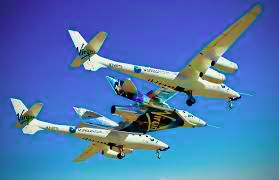 roll with elevon center sticks.
roll with elevon center sticks.
Unity is basically a suborbital craft, meaning that it cannot (yet) maintain the velocity and altitude to remain in space and orbit Planet Earth. Nevertheless, Galactic 01 did reach a height of 279,000 feet, (55 miles), shutting down its rocket engine, affording passengers breathtaking views and several minutes of unstrapped zero-gravity weightlessness. Outfitted with flight suits and protective sunglasses, those passengers, funded by Italy’s National Research Council, sought to collect biometric data, study cognitive performance and ascertain how certain solids and liquids mix in a microgravity environment. All along the scientific trio gained a measure of astronaut training for their upcoming International Space Station mission from a fourth rider, VG’s lead operational engineer.
Then Unity shifted into re-entry mode, pilots rotating, folding its massive tailbooms, the spaceplane ‘feather’ gliding back unpowered down to VG’s Spaceport America runway, truth and consequences affirmed. This entire 01 aerospace adventure lasted some 72+ minutes, and apparently went off without incident or snafus. Welcome news to Branson’s VG Holdings, Inc. which has weathered a string of setbacks and delays since its ‘SpaceShipOne’ founding in 2004. Those include a fatal ‘Enterprise’ prototype blowup in 2014 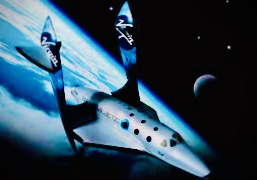 over California’s Mojave Desert, and Galactic program grounding for eleven weeks after federal regulators ruled Unity had deviated from its assigned airspace during the descent of its July 2021 test flight—Branson himself aboard there.
over California’s Mojave Desert, and Galactic program grounding for eleven weeks after federal regulators ruled Unity had deviated from its assigned airspace during the descent of its July 2021 test flight—Branson himself aboard there.
All the same, VG’s commercial space tourism vision now becomes quite clearer. With a waitlist of 800 wealthy would-be astronaut ticket holders (signed liability waivers in hand), and a limit of four seats per flight, fares currently pegged at $250k each for the initial 1k passengers could rocket to $450 per in a scheduled August redux (Galactic 02) . Add to that regular monthly flights planned henceforward, shooting toward program profitability—in larger capacity spaceplanes by 2026, eventually expanding to 400 annual flights.
So who says you can’t buy a thrill? Just ask Bezos, who’s surely hot on Sir Richard’s space-race tailbooms by now, Blue Origin even planning an international network of launch pads. (MTC…) ☟![]()
Spacecraft or Capsule? (Updates + SST : 5/26/22☟)
With Sir Richard’s having staked his Galactic claim on space as “Virgin Territory”, the commercial primacy race has clearly taken flight. But be it Branson or Bezos, with Elon Musk as a new SpaceX factor, the billionaires’ bored game is just barely hitting Mach 1 speed…
(Update: 10/25/21)—VG has since been temporarily grounded by the FAA, while the US aviation agency investigates reports that the spacecraft changed its trajectory, veering below its authorized air traffic control clearance airspace (‘entry glide cone’), for a minute and 41 seconds during mission-ending descent. However Branson’s company maintains it maneuvered safely off course momentarily upon encountering unexpected high-altitude winds.
Although since exonerated by the FAA, this airspace clearance flap and new questions about the “strength margins of certain (spaceship) materials”, mean Virgin Galactic will delay its next Unity 23 test flight, and full commercial flights are pushed back to late 2022. (MTC…)
VirginGalactic’s skybreaking 100 mile effort launched at dawn Sunday from its SpacePort America flight operations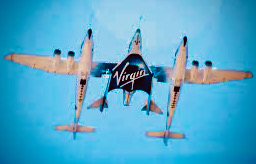 center. Carried aloft by a huge ‘mothership’, the VSS Unity 22 supersonic space plane tucked ever so neatly between WhiteKnightTwo’s innovative twin fuselages.
center. Carried aloft by a huge ‘mothership’, the VSS Unity 22 supersonic space plane tucked ever so neatly between WhiteKnightTwo’s innovative twin fuselages.
The Unity payload? VG founder Branson and three staffers, with a two-pilot cockpit crew—were all propelled up to 50,000 feet under launchship power. There the Unity craft was released from UKTwo, detached, dropping safely before its single rocket engine thrust U22 up to 282,000 feet (53+ miles) in a breathtaking 90-second climb. The crew then went from Mach 3 and 3Gs of acceleration force to unbuckled micro-gravity, weightlessly floating about Unity’s relatively spacious four-seat cabin for five minutes—blown away by the stunning panorama of Earth’s curved horizon against a vast pitch black sky.
Dramatic video captured and streamed, the sleek blue/gold suited crew buckled up again at the top of 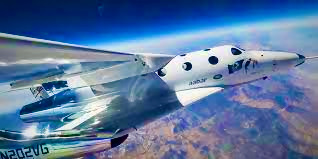 climb. Their spacecraft then flipped belly up, its twin tailbooms rotating, feathering upward like rabbit ears. Then its elevons commenced helping right the ship, configuring Unity 22 for a graceful descent from the edge of space to a soft landing at VG’s 27 square-mile New Mexico complex.
climb. Their spacecraft then flipped belly up, its twin tailbooms rotating, feathering upward like rabbit ears. Then its elevons commenced helping right the ship, configuring Unity 22 for a graceful descent from the edge of space to a soft landing at VG’s 27 square-mile New Mexico complex.
Some 17 years in development, mogul Branson’s space flight inspiration and aspirations materialized at a time when seven fat cats were paying handsomely to visit the International Space Station—until Russia pulled its patronage plug on that venture. So Virgin’s rock star astronaut now basks in this maiden flight glory, proclaiming VG’s leadership in the vanguard of pioneering 21st Century space flight—vowing to “democratize space tourism” by opening “…space to everybody and change the world for good”—starting at $450k a pop.
Leaps and Bounds.
But tell that to Amazon baron, Jeff Bezos, who had earlier grabbed headlines (beyond his Washington 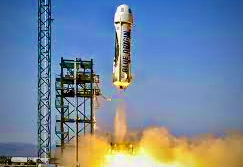 Post) upon announcing his own Blue Origin space launch on July 20—at least until Branson stole his lunch. A chippy Bezos now counters that the Unity 22 feat should be asterisked (if not catch-22ed), because VG’s suborbital flight didn’t reach “internationally recognized” so-called Kármán line of 100 kilometers, where ‘space officially begins’. Thus presumably his Blue Origin capsule will, by reaching up to 62 miles high.
Post) upon announcing his own Blue Origin space launch on July 20—at least until Branson stole his lunch. A chippy Bezos now counters that the Unity 22 feat should be asterisked (if not catch-22ed), because VG’s suborbital flight didn’t reach “internationally recognized” so-called Kármán line of 100 kilometers, where ‘space officially begins’. Thus presumably his Blue Origin capsule will, by reaching up to 62 miles high.
The United States recognizes an 80 kilometer (50 mile) space boundary, however; so na-na-na, says VG supporters. Still, other space race competitors, from Musk’s SpaceX to the Russians to an Axiom start-up by a former NASA program manager will likely have their own takes and input on all this before long…
All Hat, New Capsule.
Update: 10/13/21—As promised, Jeff Bezos’ Blue Origin program successfully completed an initial human-![]() crewed space mission today—launch to landing at its private pad/complex near Van Horn, Texas—with nary a hitch in his giddyup.
crewed space mission today—launch to landing at its private pad/complex near Van Horn, Texas—with nary a hitch in his giddyup.
The phallic-shaped New Shepard rocket ship took off from the West Texas site at 9:12 a.m (EDT), with 10-gallon-hatted Bezos and a fellow crew of three. B.O.’s first human ‘payload’ included his brother, plus the youngest and oldest passengers ever to fly into space: an 18 year-old lad (his dad paying Dutch) and female aerospace pioneer, Wally Funk, a spry and saucy 82 (only to be later aged out by 90-year-young Star Trekker, William Shatner).
New Shepard’s blue suited crew blasted into the Stratosphere, sniffing Mach 3 at a top speed of 2,233 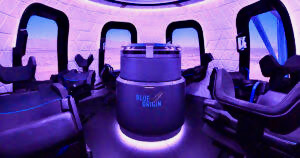 miles per hour. Some 2½ minutes after liftoff, the capsule shedding its massive booster rocket, rising to that Kármán line altitude of over 350,000 feet, upwards of 66 miles. As the booster powered down via its drag brakes and reverse engine thrust, it pinpoint descended to the launch pad at 2,500 m.p.h., aiming for a reusable role.
miles per hour. Some 2½ minutes after liftoff, the capsule shedding its massive booster rocket, rising to that Kármán line altitude of over 350,000 feet, upwards of 66 miles. As the booster powered down via its drag brakes and reverse engine thrust, it pinpoint descended to the launch pad at 2,500 m.p.h., aiming for a reusable role.
The capsule itself followed a parabolic arc along the edge of space, its crew floating in zero gravity, viewing Earth’s dazzling horizon and the darkness of the great beyond through a tiara of ‘astronomic’ windows. The entire flight lasted 10 minutes, 10 seconds, New Shepard’s capsule having gracefully returned to B.O.’s Texas desert site under the gentle sway of three huge parachutes—the blue-white orb making a dusty thump of a landing in the surrounding brush.
Onward and One-Upward?
Amazon founder Bezos capped it all off by whoopin’ for two more vertical takeoff-vertical landing (VTVL) trips on his “road to space…toward a sustainable ecosystem” in 2021, with some $100m of 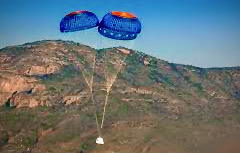 private reservations/ticket sales already booked. Meanwhile, Branson and Virgin Galactic foresee some 400 such suborbital ‘pogo’ flights in 2022, with Elon Musk quickly playing catch-up and then some via SpaceX’s estimable fully orbital experience and expertise. Update:☟
private reservations/ticket sales already booked. Meanwhile, Branson and Virgin Galactic foresee some 400 such suborbital ‘pogo’ flights in 2022, with Elon Musk quickly playing catch-up and then some via SpaceX’s estimable fully orbital experience and expertise. Update:☟
Among those who are already buying into VG’s plans for ‘the world’s first commercial spaceline’ are over 600 fat cats who have ponied up $250,000 deposits each for the 90-minute, straight up and down space flight (11/10/21—the first of whom soon perished in a down-to-Earth after-Blue Origin flight small-plane crash). For the rest of us, Branson promises to launch an Omaze Sweepstakes lottery for a limited number of ticket pairs. Virgin Galactic currently projects that its pricey, uber adrenalized amusement park rides will begin carrying paying passengers next year: All tolled, 6/7-figure ($/£/€) fares for a few precious minutes in zero gravity.
On the other hand, Blue Origin’s claim to low-impact liquid hydrogen/liquid oxygen engine power notwithstanding, the environmental cost and carbon footprints of their outlandish space adventures will undeniably factor into these billionauts’ dreams and developments racing forward.
☟ SpaceX Officio?
![]() 9/19/21—The first private orbital space flight with a civilian human payload launched successfully last Wednesday evening, although SpaceX founder, Elon Musk was not among the aboard.
9/19/21—The first private orbital space flight with a civilian human payload launched successfully last Wednesday evening, although SpaceX founder, Elon Musk was not among the aboard.
Inspiration4 lifted off successfully from Florida’s Kennedy Space Center mere minutes into its two-day 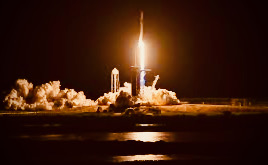 launch window, on a three-day mission to orbit the Earth at an altitude of 375 miles at 17,500 mph, some 100 miles higher than the International Space Station—besting the ‘pogo’ shots by Virgin Galactic (53 miles up) and Blue Origin (66 miles high).
launch window, on a three-day mission to orbit the Earth at an altitude of 375 miles at 17,500 mph, some 100 miles higher than the International Space Station—besting the ‘pogo’ shots by Virgin Galactic (53 miles up) and Blue Origin (66 miles high).
SpaceX’s two-stage Falcon 9 drone ship took off from NASA’s Launch Complex 39a, topped with an automated Dragon capsule, which it rocketed beyond the Earth’s atmosphere. Two and one half minutes into the flight, Falcon’s stages separated, wherein the lower, main power engine cutoff (MECO). Then in a slick flip maneuver, stage two and the Dragon were thrust aloft, while the reusable first rocket stage entry burned down toward a soft vertical landing on an offshore platform.
‘Musklessly’ crewing the 13′ wide Dragon capsule, dubbed ‘Resilience’, are four 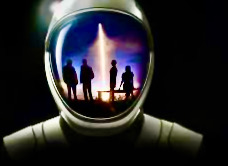 private citizens: two women and two men, trained to a near astronaut rigor. These latest space ‘tourists’ include the flight’s major bankroller (a billionaire ‘boy-wonder’ entrepreneur), along with SpaceX; a girlhood cancer survivor and physician’s assistant from St. Jude Hospital; a geoscientist/ community college teacher—and an aeronautical data engineer/space fan who landed his lofty seat via an online raffle. The entire mission is essentially a St. Jude Hospital Children’s Cancer Research fundraiser.
private citizens: two women and two men, trained to a near astronaut rigor. These latest space ‘tourists’ include the flight’s major bankroller (a billionaire ‘boy-wonder’ entrepreneur), along with SpaceX; a girlhood cancer survivor and physician’s assistant from St. Jude Hospital; a geoscientist/ community college teacher—and an aeronautical data engineer/space fan who landed his lofty seat via an online raffle. The entire mission is essentially a St. Jude Hospital Children’s Cancer Research fundraiser.
So theirs is a three-day working trip rather than just another glitzy joyride—conducting scientific research (e.g., drawing blood samples, etc.) on human health during future long-haul space flight—every hour planned, albeit amid minimal privacy or ‘elbow room’. Meanwhile, white/black trim-suited crew members are viewing the Earth and cosmos through Dragon’s ‘Copula’ 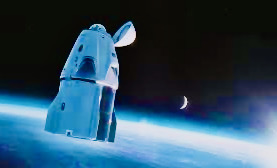 observation dome, the largest conjoined space window ever deployed. At mission’s end (47 orbits) ‘Resilience’ descended—a 3,500° re-entry with tri-parachute easing—to its pinpoint splashdown off the Florida coast, met by a fleet of SpaceX rescue ships.
observation dome, the largest conjoined space window ever deployed. At mission’s end (47 orbits) ‘Resilience’ descended—a 3,500° re-entry with tri-parachute easing—to its pinpoint splashdown off the Florida coast, met by a fleet of SpaceX rescue ships.
Otherwise, Inspiration4 is billed as the first ‘People’s Mission’ to space (1st of many?), with SpaceX running the entire operation—launchpad to lodging—independent of formal NASA administration, even though SpaceX does rent the Kennedy Center facilities from that agency. Thus Elon Musk’s imprint is all over this first private sector orbital flight, even though the busy SpaceX honcho himself appears to be officially spacing it out. Really, what must Sir Richard and Jeff Bezos be making of that? In any event, on the historic Inspiration4 front, mission well accomplished.
Now it remains to be seen which entry ultimately wins all the marbles in this spacey game. But meantime, there’s one bright, shiny marble we had better explore, embrace a bit more right down here. (MTC…)![]()
SST: Boom or Doom?
So we are on the cusp of shrinking the world with unparalleled speed and unsurpassed comfort and luxury—all over again…
Making a Machery of the Sound.
5/26/22—Not that it’s any of our business necessarily, but the latest entry in the post-Concorde sweepstakes is the Global 8000, billed as the “World’s fastest and longest-range purpose-built business jet” by aircraft manufacturer, Bombardier of Canada.
Next generation of the company’s 7500 test vehicle—which broke the sound barrier at Mach 1.015 last May—this new 19-passenger variant will top out at Mach 0.94 with a range of, yes, 8000 nautical miles. Scheduled to 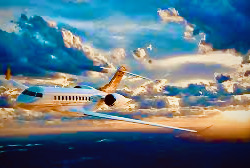 begin service in 2025, the 8000 is said to be the first transport category (borderline) supersonic jet powered with sustainable aviation fuel (SAF).
begin service in 2025, the 8000 is said to be the first transport category (borderline) supersonic jet powered with sustainable aviation fuel (SAF).
Yet the Global 8 still has some lengths to go to catch Boom Supersonic’s Overture model, touted as carrying 65-85+ passengers on more than 500 transoceanic routes at Mach 2.2 (well over 1,300 mph). Dare we say that’s a bit more our speed…
In any event, Vamigré will keep us all posted as these racy thoroughbreds hit the stretch. (MTC…)
Muffling the Sonic Boom.
![]() Update: 8/16/22—In an emerging effort to re-launch supersonic flight, NASA and aviation mavericks alike are endeavoring to turn the thunderclap sonic boom into something of a sonic ‘thump’. Gone for good, they aim, will be the forbidding days of the (long banished) Concorde and Soviet Tupolev TU-144—with their loud/guzzling, converted military engines and cramped, noisy cabins.
Update: 8/16/22—In an emerging effort to re-launch supersonic flight, NASA and aviation mavericks alike are endeavoring to turn the thunderclap sonic boom into something of a sonic ‘thump’. Gone for good, they aim, will be the forbidding days of the (long banished) Concorde and Soviet Tupolev TU-144—with their loud/guzzling, converted military engines and cramped, noisy cabins.
Turns out taming, reshaping the blasted boom, banned particularly over terra firma, is a matter of 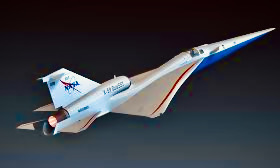 changing, redirecting the atmospheric pressure that generates that sound. A supersonic aircraft slices through it like a speedboat through sea waves, pushing air aside, rippling that pressure—which builds up on the plane’s surfaces (from nose to tail) as it nears the speed of sound—creating waves of high pressure fore and low pressure aft.
changing, redirecting the atmospheric pressure that generates that sound. A supersonic aircraft slices through it like a speedboat through sea waves, pushing air aside, rippling that pressure—which builds up on the plane’s surfaces (from nose to tail) as it nears the speed of sound—creating waves of high pressure fore and low pressure aft.
At Mach 1, the amassing waves coalesce around those surfaces, then emit to the ground as a sudden pressure change—heard as that ear aching, window rattling, car alarm triggering sound—trailing the jet plane like a coastal cutter ship’s wake.
Enter NASA’s X-59 QueSST (Quiet Supersonic Technology), a sleek beaked experimental aircraft that slims down lift and control surfaces to reduce pressure accretion, diffusing it instead over the plane’s 100-foot fuselage, so as to spread out the powerful shock waves, weakening their potential sonic din. Moreover, it seems private sector start-up companies like Denver’s Boom Supersonic are taking a not 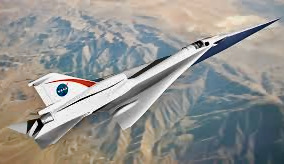 dissimilar approach to supersonic sound suppression in their aerodynamic designs. The startup plans to build an initial ‘Overture’ manufacturing plant in Greensboro, North Carolina. Boom’s target: some 700 ‘Overture’ aircraft by 2035 (American Airlines has since good-faith ordered 20 Boom SSTs for delivery beginning in 2025, optioning 20 more).
dissimilar approach to supersonic sound suppression in their aerodynamic designs. The startup plans to build an initial ‘Overture’ manufacturing plant in Greensboro, North Carolina. Boom’s target: some 700 ‘Overture’ aircraft by 2035 (American Airlines has since good-faith ordered 20 Boom SSTs for delivery beginning in 2025, optioning 20 more).
So could this be the shape of wings to come, essentially the dooming of sonic booms, revisiting the shaky promise of supersonic transport over land and sea, particularly on trans-Atlantic and trans-Pacific routes? Will we fly quietly, SAF fueled, eco-cleanly, double supersonically anywhere worldwide by decade’s end within four to five hours at $100 a pop?
Dubious analysts say the market for time-pressed premium passengers would top out at 171 such planes, and that problems of nitrogen oxide, aerosol and water vapor emissions at the higher altitudes must still be solved. Nevertheless, United Airlines has already put down investor cash on 15 Overture craft.
Hmmm, Vamigré will surely keep our eyes and ears to these skies…(MTC…)
Update: 6/3/21—Where Aerion has faltered in its AS2 supersonic aircraft program due to lack of funding, Boom ![]() Supersonic’s fortunes have soared.☟For United Airlines has just announced its intention to purchase 15 jets from the aerospace company along with an option for 35 more as soon as the Denver-based start-up designs an SST aircraft that exceeds the speed of sound, while meeting
Supersonic’s fortunes have soared.☟For United Airlines has just announced its intention to purchase 15 jets from the aerospace company along with an option for 35 more as soon as the Denver-based start-up designs an SST aircraft that exceeds the speed of sound, while meeting 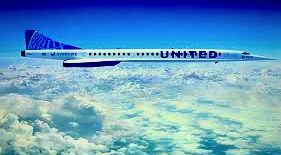 prevailing safety and environmental (decarbonization) standards. The $3b deal ($200m per plane) projects a commercial takeoff of the aircraft by 2029, with passenger carrying flights from UAL’s coastal hubs in Newark, New Jersey (to London in 3½ hours) and San Francisco (Tokyo in six)—supersonic overland flights still being a no-go.
prevailing safety and environmental (decarbonization) standards. The $3b deal ($200m per plane) projects a commercial takeoff of the aircraft by 2029, with passenger carrying flights from UAL’s coastal hubs in Newark, New Jersey (to London in 3½ hours) and San Francisco (Tokyo in six)—supersonic overland flights still being a no-go.
Boom is currently working up its ‘Overture’—a 65-88- seater that will fly at Mach 1.7 (x the speed of sound; i.e., some 1,300 mph)—the first SST powered by ‘sustainable’, energy dense fuel—from vegetative/waste products to hydrogen. Though not quite as fast as the doomed Concorde, Boom estimates its plane will cruise at twice the speed of current airliners, operating at 25% of the Concorde’s cost thanks to higher tech Rolls-Royce engines and lighter fuselages. The company targets a test flight of its one-third scale Overture prototype by year’s end or early 2022.
UAL envisions a market for both business and leisure travelers, with a cabin layout that affords economy as well as premium seating in a relative effort to ease the prohibitively high ticket costs that has plagued supersonic air travel to date. Uh-huh, we’ll be reading the contrails to see if and when this latest supersonic honey pie takes to the sky and flies, speeding up the ‘sluggish’ air transport we have today.
A Fleeting, Fiery History.
Still, there were echoes of the 1970s in a recent environmentalist op-ed piece: Supersonics are too costly, they’re too loud, they use too much fuel, they blow the ozone layer all to hell. That article could have been written amid the Nixon administration, and for all intents and purposes was. Only the targets and applicable technology have changed.
Back then, the goal was accelerated, more accessible, ‘time-efficient’ airline travel—faster, in fact, than the speed of sound. But that was where the barriers came in. The concept of commercial supersonic flight dated to the mid 1950s, to British Super-Caravelle and Bristol 223 delta wing designs—tackling the obstacles of streamlined aerodynamics, daunting lift/drag ratios and engine power demands.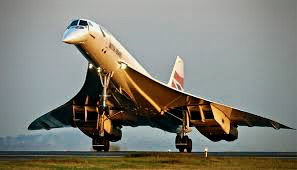
By the 1960s, concept advanced to SST prototypes, with Boeing developing a swing wing 2707, Lockheed its L-2000, and the Soviets modeling a Tupolev TU-144. But it was the Anglo-French subsidized Concorde that actually took to the commercial skies—as exclusive flagships for British Airways and Air France—luxe status with a breathtaking top speed of Mach 2. Sixteen of these sleek, modern marvels went into production, the majority seeing regularly scheduled service, largely on trans-Atlantic routes. Cutting travel times dramatically, they quickly became de rigueur for celebs, politicos, models and moguls alike.
Yet at the outset, New York’s JFK airport refused to grant Concordes landing rights, citing public complaints of the SST crafts’ excessive takeoff noise levels and fuel guzzling pollution. Though eventually following Washington D.C.’s Dulles Airport lead, the JFK resistance portended more problems to come. Travel critics soon noted the hook-nosed Concorde’s pricey fares, relatively low passenger capacity and limited range. Environmental studies soon found SST engine exhaust was depleting the earth’s water vapor levels and ozone layer, particularly its expending of nitrogen oxide. While most everyone was up in arms over the Concordes’ sonic booms—to where the aircraft were banned from flying over populated land (comprising some 75% of commercial routes). In other words, they were relegated to essentially operating over water.
This was before Boeing’s and Lockheed’s Mach 3 work-ups (AST & SST) could even get into full production despite Congressional support, much less the Soviet Tupolev Tu’s. Then came the early 1970s’ oil crisis, 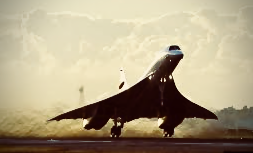 which made the Concorde’s (high jet velocity) fuel demands less cost-effective. All but sealing the SST’s demise was the introduction of Boeing’s large-capacity 747s and, more broadly, efficiently powerful new turbofan subsonic engines swiftly embraced by the airline industry worldwide.
which made the Concorde’s (high jet velocity) fuel demands less cost-effective. All but sealing the SST’s demise was the introduction of Boeing’s large-capacity 747s and, more broadly, efficiently powerful new turbofan subsonic engines swiftly embraced by the airline industry worldwide.
Thus Congress killed its AST/SST funding as impractical, a recession clipped demand for the Concordes’ pricey airfares, and the supersonic juggernaut was inexorably blown from the skies—perhaps most conclusively by Air France’s F-BTSC (CN 203)’s exploding upon takeoff on July 25, 2000. Oddly enough, British Airways has long maintained that its Concorde service did prove substantially profitable, while the trigger for that devastating Paris SST crash was likely a tire blowout due to runway debris from another plane entirely. Still, supersonic air travel was ultimately grounded by the vicissitudes of politics, business/market conditions and airborne class warfare.
SST—A .2 Redux.
So decades later, here’s the second coming of the supersonic messiah. A covey of aero start-ups are jockeying to develop a new generation of SSTs, smaller, faster and less obtrusive than the Concordes before them.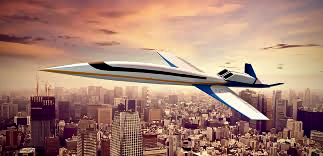
Top tier of the species are conventional business jet-size Aerion model AS2, Spike’s roomier S-512—and the even significantly larger-capacity aircraft by Denver-based Boom Supersonic Technology.
In particular, Boom’s offering is a 55 seat airliner that seeks to challenge current subsonic airlines’ premium business class on grounds of speed, comfort and accessibility. The ‘Boomer’ promises to cruise mach 2.2 smoothly at 60,000 feet, with a range of up to 10,357 miles. That is, well above today’s air traffic tribulations and turbulence, offering stunning views of the Earth’s curvature and dark space through enlarged oval cabin windows.
Contrasting its ogival delta-winged plane with SST.1’s perceived shortcomings, Boom claims tightened cost effectiveness via reduced weight and more manageable load factors (i.e., the Concorde had too many seats to fill). Fuel efficiency will be increased, the aircraft strengthened by a new lightweight, viscous drag-reducing carbon fiber composite fuselage.
Three powerful, medium-bypass, non-afterburning turbofan engines will reportedly lower takeoff noise and facilitate safer transversing of overwater routes—up to halving travel times worldwide. Boom says the craft’s quieter operation could conceivably ease resistance to supersonic routes over populated land. As to the speed-of-sound bugaboo, barrier breakage will be “low boom”—some 30 times quieter than the Concorde’s—comparatively inaudible, uneventful onboard, no broken windows nor damaged structures below.
In all, the firm touts tranquil, stress-free travel in first class-sized seating (no middling entrapment), with full service, ample underseat storage and ultra-tech productivity and/or entertainment systems—all while affording competitive fares and a quieter travel experience than many subsonic planes flying today.
Unsound Barriers?
Sky’s the limit, right? Well, let’s yank back on that yoke some while we can…
For one thing, will Boom’s three high-velocity engines really operate more cost-efficiently on a fuel burn basis than current twin-engine subsonic aircraft such as 787 Dreamliners? Or keep fares competitive over the long haul with three fuel slurping engines, given jet fuel’s per-barrel price fluctuations?
Moreover, is it realistic to claim that “low booms” will actually mitigate the well-documented effects of 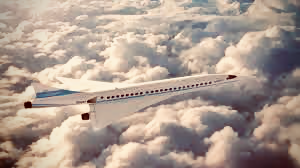 breaking the sound barrier, rendering them uneventful, if not inaudible? Can Boom Tech responsibly assert that their turbofan power plants will silence critics who bemoan the noise pollution of supersonic takeoff and flight?
breaking the sound barrier, rendering them uneventful, if not inaudible? Can Boom Tech responsibly assert that their turbofan power plants will silence critics who bemoan the noise pollution of supersonic takeoff and flight?
Or can a ‘cleaner, greener’ SST.2 truly reduce water vapor and ozone depletion any more than could the Concord’s exhaust back then—technological, materials advances or no?
Will travel times be legitimately halved and more, given the necessity of periodic service and refueling stops? Could Boom’s aerodynamic lightweight carbon fiber and carbide ceramic coated skins safely withstand the increased heat and stratospheric pressure of supersonic launch, flight and re-entry?
Furthermore, what are the human health hazards of regularly flying closer to the cosmic and solar radiation of a thinner atmosphere, anyhow? Especially pertinent now that Space X and Virgin’s VSS Unity spaceplane venture further and further into the stratosphere.
So, No Stopping ’Em? ☟
These and other issues raised in that recent environmentalist’s op-ed notwithstanding, Boom has scheduled a smaller XB-1 prototype demo flight at mach 2.2 for 2019. And both Boom and Aerion envision full service debuts by 2023. Although whether a market for 55-seat supersonic business travel will fly remains to be seen. 5/23/21--As if to amplify that challenge, Aerion Supersonic has just announced it is closing shop ![]() due to lack of further funding, despite logging $11b in backlog orders for its 12 passenger, Mach 1.4 supersonic AS2 business jet.
due to lack of further funding, despite logging $11b in backlog orders for its 12 passenger, Mach 1.4 supersonic AS2 business jet.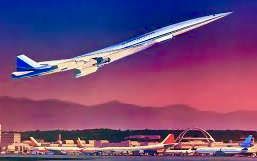
In any event, there is not stopping travel technology, and no chance of returning to stagecoaches or wagon trains. For today we have not just several space capsules and a moonshot to draw on, but stable space stations, constant payload launches, private-sector space flights and a rush-hour orbiting of countless satellites this time. Besides, Boom Tech already cites 76 plane orders, tens of millions of dollars in non-refundable pre-payments—and the financial backing of more and more major carriers.
Beyond that—indeed, over 200,000 feet above and beyond, at 2.9 times the speed of sound—comes SpaceShip Two. Virgin Galactic now noses ahead in the passenger race to commercial space with the successful set flight over 50 miles above California’s Mojave Desert, the NASA designated edge of outer space. Richard Branson’s ‘space tourism’ venture has rebounded from a fatal 2014 accident of a previous launch effort to beat rivals Jeff Bezos’s Blue Origin and Elon Musk’s Space-X at blasting travelers and small satellites into space via cheap rockets and/or carrier aircraft. Both operations project carrying paying passengers outside earth’s atmosphere, perhaps as early as the coming year. Fare for breathtaking views and several minutes of weightlessness: some $250,000, for starters, bag and beverage fees to be announced…
Who knows, maybe if the ‘Boomer’, et al, siphon off enough subsonic business travelers, it will leave more room, lighten the load for the rest of us. So Vamigré will continue to monitor SST.2 R&D with a keen eye and ear towards the wild black-and-blue yonder.
![]() Along those lines, Vamigré notes that U.S. aviation regulators are currently planning to soften noise restrictions on testing commercial supersonic planes in domestic skies. Stating that “Supersonic aircraft are back on the horizon,” acting FAA chief Daniel Elwell pledged the agency is readying unprecedented noise standards for takeoffs and landing tests. Pegged to a developmental plane’s size, supersonics would be allowed more takeoff noise than today’s wide body airliners. Elwell added that “We don’t (want to) become a hindrance to the movement of this technology for commercial applications”. While Transportation Department deputy secretary David Short expressed hope that “…We can get some sort of global consensus on long-term noise standards to pave the way for widespread supersonic operations.” Although nothing has been mentioned about concurrent pollution standards, nor the specter of Mach-busting sonic booms so far.
Along those lines, Vamigré notes that U.S. aviation regulators are currently planning to soften noise restrictions on testing commercial supersonic planes in domestic skies. Stating that “Supersonic aircraft are back on the horizon,” acting FAA chief Daniel Elwell pledged the agency is readying unprecedented noise standards for takeoffs and landing tests. Pegged to a developmental plane’s size, supersonics would be allowed more takeoff noise than today’s wide body airliners. Elwell added that “We don’t (want to) become a hindrance to the movement of this technology for commercial applications”. While Transportation Department deputy secretary David Short expressed hope that “…We can get some sort of global consensus on long-term noise standards to pave the way for widespread supersonic operations.” Although nothing has been mentioned about concurrent pollution standards, nor the specter of Mach-busting sonic booms so far.
In any event, we’ll ultimately see whether speed thrills again, or is re-killed…
